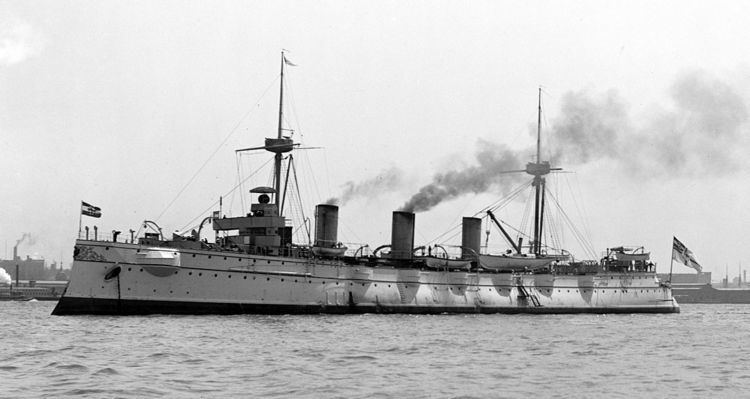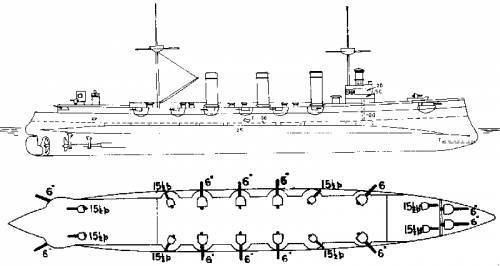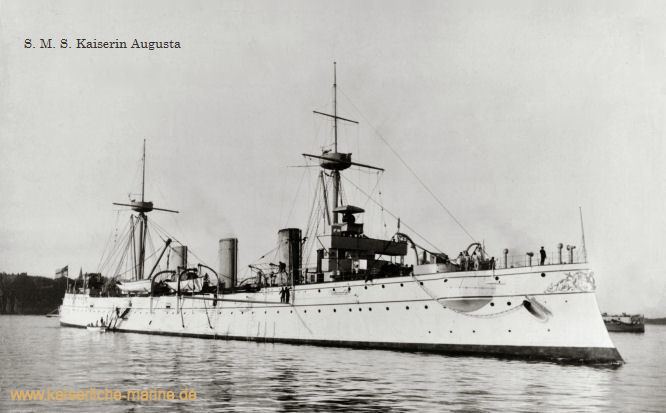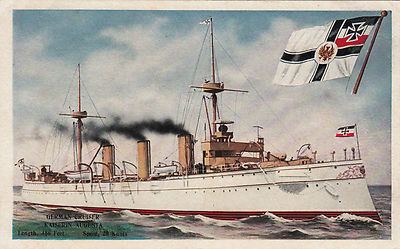Name SMS Kaiserin Augusta Commissioned 17 November 1892 Fate Scrapped 1920 Launched 15 January 1892 | Laid down 1890 Struck 1 October 1919 Construction started 1890 Length 123 m | |
 | ||
Builder Friedrich Krupp Germaniawerft | ||
Did you know sms kaiserin augusta
SMS Kaiserin Augusta was a unique protected cruiser, built for the German Kaiserliche Marine (Imperial Navy) in the early 1890s. Named for Empress Augusta, who died in January 1890, she was laid down in 1890, launched in January 1892, and completed in November of that year. Owing to budgetary restrictions, Kaiserin Augusta was designed to fill both fleet scout and colonial cruiser roles. The ship was initially armed with a main battery of four 15 cm (5.9 in) and eight 10.5 cm (4.1 in) guns, which by 1896 was replaced with twelve new model 15 cm guns. She was the first ship in the German Navy to feature a three-shaft propeller arrangement.
Contents
- Did you know sms kaiserin augusta
- Design
- General characteristics and machinery
- Armament
- Service history
- References

Kaiserin Augusta served abroad between 1897 and 1902, primarily in the East Asia Squadron under the command of Admiral Otto von Diederichs. During this time, the ship's crew assisted in the suppression of the Boxer Rebellion in 1900. In 1902, she returned to Germany for an extensive overhaul that lasted until 1907, after which she went into reserve. Following the outbreak of World War I in 1914, Kaiserin Augusta was mobilized to serve as a gunnery training ship. She served in this role throughout the war; the ship was ultimately sold for scrapping in October 1919 and broken up the following year.

Design

Design work on Kaiserin Augusta began in 1887; budgetary restrictions forced the German Navy to design a ship that could serve in both colonial and fleet scout roles. During the design process, it was determined a three-shaft arrangement of the machinery would be necessary to attain the high speed requirement. This resulted in the first warship of the German Navy to use three screws. This was a relatively novel development; at the time of Kaiserin Augusta's construction, only a handful of French and American ships had experimented with the arrangement, and had not yet been to sea for a thorough evaluation of the design. Kaiserin Augusta was laid down at the Germaniawerft shipyard in Kiel in 1890. She was launched on 15 January 1892 and commissioned into the fleet less than a year later on 17 November 1892.
General characteristics and machinery

Kaiserin Augusta was 122.2 meters (400 ft 11 in) long at the waterline and 123.2 m (404 ft 2 in) overall. She had a beam of 15.6 m (51 ft 2 in) and a draft of 6.48 m (21 ft 3 in) forward and 7.4 m (24 ft 3 in) aft. She was designed to displace 6,056 metric tons (5,960 long tons), and at full combat load the displacement increased to 6,318 t (6,218 long tons). Her hull was constructed with transverse and longitudinal steel frames; the outer wall consisted of a single layer of timber planks covered with Muntz metal sheathing to protect the hull from fouling. The hull contained 10 watertight compartments and a double bottom. A double bottom ran for 55 percent of the length of the hull. The ship's armor consisted of Krupp steel; the deck was 50 millimeters (2.0 in) thick with 70 mm (2.8 in) thick sloping sides. The conning tower had 50 mm thick sides and a 20 mm (0.79 in) thick roof.

Kaiserin Augusta's crew consisted of 13 officers and 417 enlisted men. She carried several smaller boats, including two picket boats, one launch, one pinnace, two cutters, two yawls, and two dinghies. The ship suffered from severe pitch and roll, though these effects were reduced in heavy winds and a beam sea. The forecastle shipped excessive amounts of water in a head sea. The ship maneuvered poorly, though this was improved at high speed. The transverse metacentric height was .78 m (2 ft 7 in).
The ship was powered by three 3-cylinder triple expansion engines built by AG Germania; each drove a screw that was 4.5 m (14 ft 9 in) in diameter. Each engine had its own separate engine room. The engines were supplied with steam by eight cylindrical double boilers split into three boiler rooms. The engines were rated at 12,000 indicated horsepower (8,900 kW) and a top speed of 21 kn (39 km/h; 24 mph), though on trials they reached a half knot better at 14,015 ihp (10,451 kW). This rendered her one of the fastest cruisers in the world at the time. Kaiserin Augusta was equipped with four electrical generators providing 48 kilowatts at 67 volts. Steering was controlled by a single rudder.
Armament
As built, Kaiserin Augusta was armed with four 15-centimeter (5.9 in) K L/30 guns with a total of 292 rounds of ammunition, eight 10.5 cm (4.1 in) SK L/35 guns with 777 rounds of ammunition, eight 8.8 cm (3.5 in) SK L/30 guns with 1,361 rounds of ammunition, and four machine guns. The ship was also equipped with five 35 cm (14 in) torpedo tubes with thirteen torpedoes; four were placed in swivel mounts on the broadside and one was placed in the bow, below the waterline. In 1896, her armament was updated; the old 15 cm and 10.5 cm guns were replaced with twelve 15 cm SK L/35 guns that had a maximum range of 12,600 m (41,300 ft). The guns were supplied with a total of 1,064 shells. After 1907, the swivel-mounted torpedo tubes were removed, leaving only the tube in the bow with three torpedoes.
Service history
In early 1893, Kaiserin Augusta and Seeadler conducted a good-will visit to the United States, a belated celebration of the 400th anniversary of Columbus's first voyage across the Atlantic. On 21 June 1895, the Kaiser Wilhelm Canal, connecting the North and Baltic Seas, was opened; Kaiserin Augusta was present during the opening ceremonies. She led a group of twenty-one unarmored ships, in company with the four Brandenburg-class battleships, the four Sachsen-class ironclads, and four of the Siegfried-class coastal defense ships. Later that year, the ship took part in an expedition to Morocco along with the coastal defense ship Hagen and the frigates Marie and Stosch to secure an indemnity demanded in the aftermath of the murder of two Germans. The operation was heavily criticized, especially in Britain, where anti-German sentiment was beginning to rise.
In February 1897, an international naval demonstration took place off Crete, to protest Greece's annexation of the island. Kaiserin Augusta was the sole German contribution to the force, until she was ordered to the Far East, at which point she was replaced by the old ironclad Oldenburg. Immediately following the seizure of the Kiautschou Bay concession in China, Admiral Otto von Diederichs, the commander of the East Asia Squadron, requested reinforcements to secure the new colonial territory. In mid-November, he specifically requested Kaiserin Augusta and additional ground troops to garrison the port. The ship was joined by the cruisers Deutschland and Gefion, which carried the III Seebataillon, and Cormoran. As Kaiserin Augusta had been stationed in the Mediterranean, she arrived first, on 30 December.
Following the outbreak of the Spanish–American War in 1898, Diederichs was ordered to proceed to the Philippines, where Commodore George Dewey had defeated a Spanish squadron commanded by Rear Admiral Patricio Montojo. Diederichs was instructed to protect local German interests, and if possible, seize another colonial concession in the Philippines. With his ships dispersed on various colonial missions or under repair, Diederichs initially concentrated his forces slowly; he recalled Kaiserin Augusta to serve as his flagship while the rest of the force assembled. After the end of the Battle of Manila, Kaiserin Augusta steamed to Hong Kong where the ship notified Berlin of the defeat of the Spanish garrison. She also carried the former Governor General of the Philippines, Basilio Augustín, out of Manila. The ship left Filipino waters on 13 August and arrived two days later.
Kaiserin Augusta remained stationed in Asia and participated in the international effort to suppress the Boxer Rebellion in 1900. She contributed landing parties to Admiral Edward Seymour's relief force, based in Tientsin. In 1902, the ship returned to Germany for an extensive overhaul, which began in 1903, and lasted until 1907. During the refit, the ship's generators were replaced with more powerful units that more than doubled electrical output, at 124 kW at 110 V. Her bridge was significantly expanded, with a second deck and extended aft of the foremast. The three funnels were lengthened by 2 m (6 ft 7 in) and one searchlight was installed on each of the mast tops. The four swivel-mounted torpedo tubes were also removed during this period. After emerging from the modernization, the ship was placed in reserve.
Following the outbreak of World War I in 1914, Kaiserin Augusta was reactivated for use as a gunnery training ship, to replace more modern ships that joined the High Seas Fleet. To facilitate the training of gunners, the ship's armament was diversified. She carried one 15 cm SK L/45 gun, four 10.5 cm SK L/45 guns, four 8.8 cm (3.46 in) SK L/45 guns, four 8.8 cm SK L/35 guns, five 8.8 cm SK L/30 guns, and one 8.8 cm SK L/30 gun in a U-boat mounting. She served in this capacity for the duration of the war, until she was decommissioned 14 December 1918. The ship was formally stricken from the naval register on 1 October 1919 and sold to Norddeutsche Tiefbauges in Berlin, and broken up the next year in Kiel-Nordmole.
